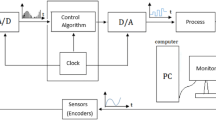Abstract
The goal of the European project muFly is to build a fully autonomous micro helicopter, which is comparable to a small bird in size and mass. The rigorous size and mass constraints infer various problems related to energy efficiency, flight stability and overall system design. In this research, aerodynamics and flight dynamics are investigated experimentally to gather information for the design of the helicopter’s propulsion group and steering system. Several test benches are designed and built for these investigations. A coaxial rotor test bench is used to measure the thrust and drag torque of different rotor blade designs. The effects of cyclic pitching of the swash plate and the passive stabilizer bar are studied on a test bench measuring rotor forces and moments with a 6–axis force sensor. The gathered knowledge is used to design a first prototype of the muFly helicopter. The prototype is described in terms of rotor configuration, structure, actuator and sensor selection according to the project demands, and a first version of the helicopter is shown. As a safety measure for the flight tests and to analyze the helicopter dynamics, a 6DoF vehicle test bench for tethered helicopter flight is used.
Similar content being viewed by others
References
Noth, A., et al.: Autonomous Solar UAV for Sustainable Flights. Springer, ch. 12, pp. 377–405 (2007)
Taylor, C.N.: Techniques for overcoming inaccurate pose estimates in mavs. In: Proc. (IEEE) International Conference on Intelligent Robots (IROS’07), San Diego, USA (2007)
Grasmeyer, J., Keennon, M.: Development of the black widow micro air vehicle. In: Proc. 39th AIAA Aerospace Sciences Meeting and Exhibit, Reno, USA (2000)
Kemp, C.: Visual control of a miniature quad-rotor helicopter. Ph.D. dissertation, University of Cambridge (2006)
Wang, W., et al.: Autonomous control for micro-flying robot and small wireless helicopter x.r.b. In: Proc. (IEEE) International Conference on Intelligent Robots (IROS’06), Beijing, China (2006)
Bouabdallah, S., et al.: Design and control of an indoor coaxial helicopter. In: Proc. (IEEE) International Conference on Intelligent Robots (IROS’06), Beijing, China (2006)
Bohorquez, F.: Design, Analysis and Performance of a Rotary Wing Mav. Alfred Gessow Rotorcraft Center, USA (2001)
Pines, D., Bohorquez, F.: Challenges facing future micro air vehicle development. AIAA J. Aircraft, 43(2), 290–305, (2006)
Bohorquez, F., et al.: Hover performance of rotor blades at low reynolds numbers for rotary wing micro air vehicles. An experimental and cfd study. AIAA Paper 2003-3930 (2003)
Coleman, C.P.: A Survey of Theoretical and Experimental Coaxial Rotor Aerodynamic Research. NASA Technical Paper 3675 (1997)
Drela, M.: X-foil subsonic airfoil development system. http://raphael.mit.edu/xfoil (2004)
Griffiths, D., Leishman, J.: A study of dual-rotor interference and ground effect using a free-vortex wake model. In: Proc. of the 58th Annual Forum of the American Helicopter Society, Montréal, Canada (2002)
Bramwell, G.D.A.R.S., Balmford, D.: Helicopter Dynamics. Butterworth-Heinemann (2001)
Author information
Authors and Affiliations
Corresponding author
Rights and permissions
About this article
Cite this article
Schafroth, D., Bouabdallah, S., Bermes, C. et al. From the Test Benches to the First Prototype of the muFly Micro Helicopter. J Intell Robot Syst 54, 245–260 (2009). https://doi.org/10.1007/s10846-008-9264-z
Received:
Accepted:
Published:
Issue Date:
DOI: https://doi.org/10.1007/s10846-008-9264-z



